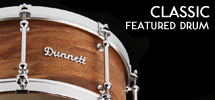THE METRICS OF SOUND
(or as Modern Drummer once put it "The Gospel according to Ronn.")
There's a reason why Dunnett Classic drums sound so good. It's not by chance. I've put years into research & development, but even that work has to come from an idea, and these are some of mine. But before I get to that I want to point out the single most important element of any drum: your ears. It doesn't matter how great a snare drum is if you can't hear. So please - protect your hearing at all times. I'm very happy to provide information on what I believe are the best attenuators for drummers - I'll be including that information in the owner's manual section once I have that completed. Until then, feel free to send me an email. Are we clear on that? Good! Let's move on...
ARCHITECTURE
Weight
It's an important and widely misunderstood concept when it comes to building a great sounding snare drum. Shell weight and hardware mass / distribution define the voice of a drum. A common misconception is that a heavier drum can achieve greater volume. That is not the case and as I have said many times, there are no loud drums - only loud drummers. I use the paint can analogy: which metal paint can would generate more volume, one full of water or one that was empty? Weight and mass variables determine the voice of a drum as much as a drum's dimensions. Contrary to popular trends based on myths and misinformation, my designs focus on shell weight. Combined with low mass/minimal contact hardware, efficient use of lugs (8 maximum) and undersized shells, Dunnett Classic drums have an incredible inherent resonance, full range dynamics and a pure, rich tone. You may not prefer a drum with this much power and resonance, but remember one thing about resonance - you can always dial in those elements, but they HAVE to be there in the first place.
Bearing edge
Think cymbals for a moment, specifically the difference between a crash and a china type. What makes them sound so different? The flange. Bend something and you alter the way it resonates. That principle also applies to a metal drum shell. Virtually all metal snare drums currently available have a flange that serves as a (blunt) bearing edge. Dunnett Classic drums do not have a flange and as a result resonate clear and clean with full sustain. Simple logic. And of course non-flanged edge also provides for easy and precise tuning/tensioning.
Shell
As with wood, the gauge (thickness) of a metal shell determines how much the shell will weigh and that in turn will determine what the drum's characteristics. Consider the difference between solid and hollow body guitars. The construction (read : weight) of the hollow body makes it acoustically ideal. The weight of a Dunnett Classic shell is tuned for optimum overall performance. Heavier shells (as in the 3mm+ shells some companies offer) are effectively "solid body" with the voice coming more from the heads than from the drum as a whole ( and at 25lbs or more it makes for a REALLY heavy drum, or a light boat anchor!).
INNOVATION
Sometimes trying new ideas - even little things - can make a big difference.
Venting
You won't find the traditional "breather" hole or air vent on a Dunnett Classic drum. With the advent of my patented Hypervent™ I and II systems you have a choice of either playing an open shell (vented) or a closed shell (non-vented) drum. Why is that an important option? In a non-vented shell, the air inside the drum acts as a highly efficient pnuematic transducer, carrying the vibration of the top head to the bottom on a 1:1 ratio. In no way does this inhibit the free movement of the head. Thus a drum without a vent is more sensitive and more responsive. However, under certain extreme conditions ie: aggressive playing, the drum may require venting. Hypervent™ I allows you to open the shell with the turn of a dial.
Snare Beds
Snare beds are required for a snare drum to function and a properly engineered and applied bed makes a huge difference in response and performance. All Dunnett Classic snare drums feature "soft" beds - beds that are beautifully contoured, deep and cut to run just past the lugs on either side of the throw off/butt. This design eliminates snare "buzz" and accommodates the use of wider 42 strand snares. For more information on snare beds please read my Snare Bed Primer by clicking here.
Cryogenics
In March 2000 Dunnett Classic became the first and so far only company to employ cryogenic processing of drum shells. Cryo tempering acts as a "sonic preservative" that maintained the tonal characteristics of non-ferrous metal shells such as brass, bronze and copper. Currently I am not offering Dunnett Classics made from these materials. If you are looking for an excellent quality snare drum from one of these materials I invite you to visit the George Way Drum company web site at www.georgewaydrums.ca.
AESTHETICS
One of the drawbacks of metal shell drums was that you had a very limited choice of finishes, if any. Now we have a choice : 4 natural metal finishes and a virtually unlimited selection of colour coatings including sparkle and translucent finishes. These finishes can even be combined to create unique effects. Dunnett coatings are applied in such a way that they have no effect on the tone of the drum. Ever wish you could have a metal shell to match your wrapped kit? Who says you can't?
Raw finish is available on Titanium, Stainless Steel and on plate iron (The Sledge) shells. I do not offer lacquering or any protective clear coating on any metal shells. Raw shells are a "living finish", one that will age and patina with time much like a cymbal.
VALUE
Face it, good drums aren't cheap. (And an expensive drum ain't always good!) They are an investment. I offer drums of the highest quality, unique in sound and appearance at a price that is reasonable and affordable. I have heard some people say that offering an affordable price somehow diminishes product quality in the eyes of a potential client or, in other words, if it's inexpensive its cheap. And that may very well be true in some cases, but not with the drums I build. No expense is spared in the creation of one of my drums from the shell right down to the last stainless steel screw. Obviously drum making is a very competitive business and products are subject to comparison. I like that. I invite you to compare a "Standard Classic" with anything available in its class to see how it measures up. I think you'll be impressed.
TRUTH
I've put this info on the site because I feel that if you take the time to read it, it makes sense. Beyond all the theory, talk, ideas, endorsements, advertising and nonsense that surrounds drumming there's only one thing that counts-how a drum speaks to you. Base your drum purchasing decision on that and you'll never regret it.






